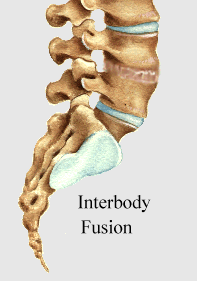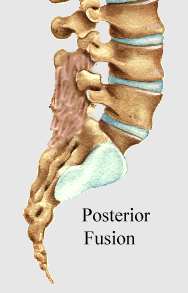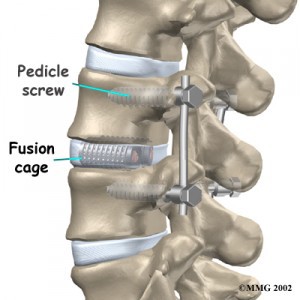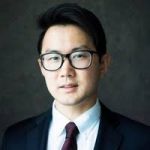The purpose of spinal fusion is to relieve your pain by stopping the movement in the spinal segment that is causing your problem. Very commonly, at the time of surgery, a decompression will be performed as well to relieve any pinching of nerves that may be ongoing. There are numerous ways lumbar fusion can be performed. It can be performed through an incision in the back, in incision on your side, or an incision on your abdomen, or any combination of the above, depending on the cause and extent of your problem.
The goal of fusion surgery is to promote the solid union between two or more vertebrae. Typically hardware, called instrumentation is utilized to achieve this goal. The hardware holds the vertebrae together so the two bones can heal together. There are two main ways that spinal fusion occurs:
 Interbody fusion
Interbody fusion
An interbody fusion occurs between the vertebrae, in the space where the disc once was. During surgery, the disc is removed (discectomy) and an interbody cage (that is loaded with bone graft and/or biologic) is placed into the disc space. In most situations, the interbody is supported with screws and rods in the back of the spine (i.e. posterior instrumentation). The instrumentation protects and immobilizes the bones, allowing the bone graft and the vertebrae to join together. This results in a solid piece of bone between the vertebrae.
Interbody fusions can be performed through an incision in the abdomen (anteriorly, known as an anterior lumbar interbody fusion), through the back (posteriorly, known as a posterior lumbar interbody fusion or transforaminal lumbar interbody fusion), or from the side (lateral lumbar interbody fusion or oblique lumbar interbody fusion).
 Posterior fusion
Posterior fusion
Currently, posterior fusions are performed with use of screws and rods. Screws anchor into the vertebral bodies, and rods connect these screws together to impart stability to the bones while they heal. Bone graft is then placed on the back sides of the vertebrae. During the healing process, the bone graft and the vertebrae join together with the goal of creating a solid piece of bone between the vertebrae involved.
Posterior fusions can be achieved through larger midline incisions, or in certain situations, through more minimally invasive (smaller) incisions.
The goal of any fusion surgery is the same: to promote the fusion of vertebrae to one another. This immobilizes the vertebrae, relieving your pain, and preventing your symptoms from getting worse.
As you can see, there are many techniques surgeons can use to fuse the spine. They all involve placing some sort of bone graft between or on the vertebrae in an attempt to make them fuse together. The bone can come from the patient (autograft) or can be derived from cadaver bone (allograft). There are also synthetic biologics that can be used to promote bone fusion. Most fusions nowadays use a combination of all the above.
If autograft is used (i.e. your own bone), it is typically harvested during the time of surgery. While in some cases it may be taken from your pelvis, oftentimes, the bone that is removed when decompressing the nerves of the spine (i.e. during a decompression) is just reused as graft.
Complete fusion usually takes about 4 to 6 months. Your surgeon will take periodic X-rays to see whether or not your bones are healing well during this period of time.

Note that the information in this article is purely informative and should never be used in place of the advice of your treating physicians.
Lumbar Spinal Fusion
Table of Contents
Lumbar Spinal Fusion
Most Common Causes of Lumbar Back Pain
Your Visit With The Surgeon
Getting Yourself Ready For Surgery
Understanding Back Precautions
Making Arrangements For Surgery
Your Hospital Visit
Lumbar Spinal Fusion Surgery
Recovery At Home
When To Call Your Surgeon
Long Term Care For Your Back
More Information:
